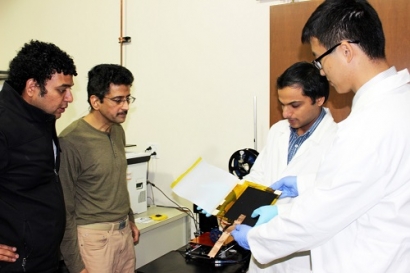
In March 2017, a group of physicists at CNI invented the ultra-simple triboelectric nanogenerator or U-TENG, a small device made of plastic and tape that generates electricity from motion and vibrations. When the two materials are brought together — through such actions as clapping the hands or tapping feet — they generate voltage that is detected by a wired, external circuit. Electrical energy, by way of the circuit, is then stored in a capacitor or a battery until it’s needed.
Nine months later, in a paper published in the journal Advanced Energy Materials, the researchers reported that they had created a wireless TENG, called the W-TENG, which greatly expands the applications of the technology.
The W-TENG was engineered under the same premise as the U-TENG using materials that are so opposite in their affinity for electrons that they generate a voltage when brought in contact with each other.
In the W-TENG, plastic was swapped for a multipart fiber made of graphene — a single layer of graphite, or pencil lead — and a biodegradable polymer known as polylactic acid. PLA on its own separates positive and negative charges but is not very good at conducting electricity, which is why the researchers paired it with graphene. Kapton tape, the electron-grabbing material of the U-TENG, was replaced with Teflon, the coating used on cookware.
“We use Teflon because it has a lot of fluorine groups that are highly electronegative, whereas the graphene-PLA is highly electropositive. That’s a good way to juxtapose and create high voltages,” said Ramakrishna Podila, corresponding author of the study and an assistant professor of physics at Clemson.
To obtain graphene, the researchers exposed its parent compound, graphite, to a high frequency sound wave which sliced the graphite into layer after layer of graphene. This is how CNI is able to scale up production of graphene to meet the research and development demands of the W-TENG and other nanomaterial inventions in development.
After assembling the graphene-PLA fiber, the researchers pulled it into a 3-D printer and the W-TENG was born.
The end result is a device that generates a maximum of 3,000 volts — enough to power 25 standard electrical outlets or even smart-tinted windows or a liquid crystal display monitor. Because the voltage is so high, the W-TENG generates an electric field around itself that can be sensed wirelessly. Its electrical energy can be stored wirelessly in capacitors and batteries.
The wireless applications of the W-TENG are abundant, extending into resource-limited settings, such as in outer space, the middle of the ocean or even the battlefield. As such, Podila says there is a definite philanthropic use for the team’s invention.
“Several developing countries require a lot of energy, though we may not have access to batteries or power outlets in such settings,” Podila said. “The W-TENG could be one of the cleaner ways of generating energy in these areas.”
The team of researchers, again led by Mallineni, is in the process of patenting the W-TENG through the Clemson University Research Foundation. Professor Apparao Rao, director of the Clemson Nanomaterials Institute, is also in talks with industrial partners to begin integrating the W-TENG into energy applications.
However, before industrial production, Podila said more research is being done to replace Teflon with a more environmentally friendly, electronegative material.
Will the W-TENG make an impact in the realm of alternative, renewable energies? Rao said it will come down to economics.
“We can only take it so far as scientists; the economics need to work out in order for the W-TENG to be successful,” Rao said.
The team’s paper, detailing the advent of the W-TENG, was published in the journal Advanced Energy Materials in December 2017. Startup funds for the study were provided by Clemson University and by the University’s Watt Family Innovation Center (grant number 2301812.) The researchers at the Clemson Nanomaterials Institute are wholly responsible for the content of this study, of which the funders had no input.
Information provided by Clemson University
Photo: Ramakrishna Podila (left), Apparao Rao, Sai Sunil Mallineni and Yongchang Dong are collaborators on the W-TENG technology.
Image Credit: Ramakrishna Podila / Clemson Nanomaterials Institute

